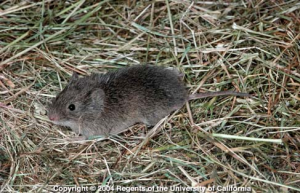Roger A. Baldwin and Ryan Meinerz, Department of Wildlife, Fish, and Conservation Biology, University of California-Davis, Davis, California; and Gary W. Witmer and Scott J. Werner, USDA/APHIA/Wildlife Services-National Wildlife Research Center, Fort Collins, Colorado
Recent research has shown we may have a new tool to protect trees and vines from vole damage. However, this product is not currently registered for such a use. We need your response to know whether there’s enough interest in a new way to control vole damage to warrant seeking registration.
Voles are short, stocky rodents that often cause extensive girdling damage to a variety of tree and vine crops throughout California. Effective management has often relied on some combination of vegetation removal, exclusion using trunk protectors, and rodenticide application.
However, all these management solutions have shortcomings. Vegetation removal doesn’t always eliminate all problems in an area. Trunk protectors should be buried at least 6 inches below ground, increasing the labor required to protect trees and vines. Rodenticide applications are generally not allowable within an orchard or vineyard during the growing season, when it is most needed.
Clearly there is room for a new tool to be added to the proverbial IPM toolbox when it comes to managing voles in orchard and vine crops. In recent experiments with a chemical repellent, anthraquinone, on citrus trees, we found that anthraquinone was highly repellent following trunk application (sprayed or painted on), with a >90% reduction in girdling damage observed following application regardless of the season when it was applied. Anthraquinone exhibited substantial longevity, with no increase in girdling damage observed for the entire summer (5 weeks) and spring (6 weeks) sampling periods. This clearly indicates substantial repellency for anthraquinone applications, with repellency to last for at least two months, and likely for much longer.
These results clearly indicate effective repellency of voles following anthraquinone applications, but at this time, anthraquinone is not registered for use against any mammalian species. We are hoping to gauge the interest of growers for the registration of this repellent against voles in orchard and vine crops. This is where we need your help. We have developed a very short survey (will take less than 3 minutes to complete) to gauge this interest. Please take this very quick survey to assist in this effort.



Leave a Reply